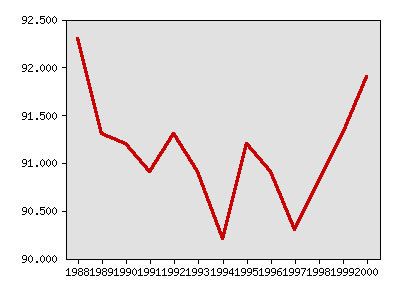What were things like in 2002?
The following idicator summary is from the 2002 Minnesota Milestones and does not neccessarily reflect the current data trends.Indicator : Health insurance
The survey that provides these statistics does not differentiate between full coverage and insurance that covers only major illness and hospitalization. People with inadequate insurance or no insurance often forgo routine preventive care.

| Year | Data |
|---|---|
| Percentage of Minnesotans with private or public health care insurance, Minnesota Department of Health | |
| 1988 | 92.3% |
| 1989 | 91.3% |
| 1990 | 91.2% |
| 1991 | 90.9% |
| 1992 | 91.3% |
| 1993 | 90.9% |
| 1994 | 90.2% |
| 1995 | 91.2% |
| 1996 | 90.9% |
| 1997 | 90.3% |
| 1998 | 90.8% |
| 1999 | 91.3% |
| 2000 | 91.9% |
Groups with lower insurance coverage include lower-income people, those born outside the United States, and young adults age 18 to 24. Health insurance rates among those born outside the United States increase with length of residence and citizenship.
In 2000 the University of Minnesota's School of Public Health was awarded a three-year, $4 million federal grant to help states nationwide assess their insurance needs. More detailed information about the characteristics of the uninsured should help policy-makers target interventions more effectively.
Since 1990 the Health Department has used the Minnesota Health Access Survey, an annual telephone poll, to track uninsurance rates in the state. Minnesota Milestones uses the Current Population Survey (CPS) based on annually updated census information.
The rate of change reported in these two surveys has been very similar, but the absolute uninsurance rates reported from the CPS and the Minnesota Health Access Survey are different because the surveys use different definitions of uninsurance. The CPS uninsurance rate is a measure of the percent of people uninsured at some time during the previous year. The uninsurance rate from the Minnesota Health Access Survey is a measure of the percent of people uninsured at the time of the survey. Over time, the CPS uninsurance rate has consistently been about 50% higher than the uninsurance rate from the Minnesota Health Access Survey.
- Percentage of children under 18 covered by health insurance (Minnesota Department of Health, www.health.state.mn.us)
- Life expectancy at birth and age 65 by gender, race and ethnicity (Minnesota Planning, State Demographic Center, www.health.state.mn.us)
- Cancer rate (Minnesota Department of Health, www.health.state.mn.us)
- Infectious disease rate (Minnesota Department of Health, www.health.state.mn.us)
- Leading cause of death for selected age groups by gender, race and ethnicity (Minnesota Department of Health, www.health.state.mn.us)
- Percentage of children under 18 covered by health insurance (Minnesota Department of Health, www.health.state.mn.us)
- Life expectancy at birth and age 65 by gender, race and ethnicity (Minnesota Planning, State Demographic Center, www.health.state.mn.us)
- Cancer rate (Minnesota Department of Health, www.health.state.mn.us)
- Infectious disease rate (Minnesota Department of Health, www.health.state.mn.us)
- Leading cause of death for selected age groups by gender, race and ethnicity (Minnesota Department of Health, www.health.state.mn.us)





